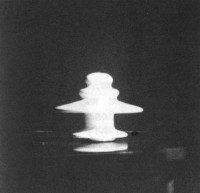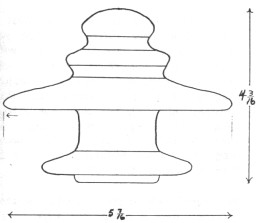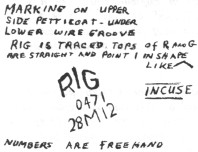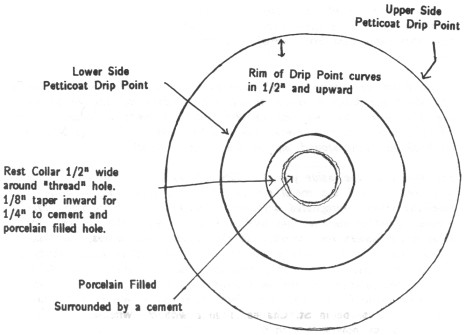Foreign Insulators
by Marilyn Albers
Reprinted from "Crown Jewels of the Wire", August 1985, page 10
FLYING SAUCERS
You will see quite an interesting story unfold as you read the following letters that
passed between Ward Lindstrom (New Jersey) and me over the past several months. Let
me share them with you. The picture and two drawings of
his "flying saucer" insulator were included in his first letter.
- - - - - - - - - -
Dear Marilyn,
As you can tell by my number, I am a new member of the NIA. I started
collecting glass insulators in the late 1960's, but I thought I was alone, so my
collecting was sporadic over the past 15 years. I wish I had known about
the NIA years ago. I kept thinking it was too bad that there wasn't an
association of collectors! I lived in Dallas from 1918 to 1981, too. Ah, well!
I have been so occupied with classifying my glass insulators that the 100+
porcelains have taken a back seat. I have a sister-in-law living in Bremen,
Germany, who sends insulators for Christmas and my birthday, so I never know
what to expect from her. She gets them at an electrical company dump several
miles outside of Bremen. As far as I know, all of my insulators from Germany
came from there except my U-1890. This one was brought to Bremen from
Bremerhaven, but I don't know where it was found.
I am sending you some shadow drawings that may be of use to you, as well as
some pictures of my favorite porcelain. If you have already gotten this
information since publication of your book, just toss all of this stuff.
In addition to the "flying saucer" insulator, I will give a brief rundown
on some of my other pin-types.
I am planning to be in St. Charles in June with my wife, Eva. Hope to see you
there. I'm looking forward to meeting other NIA members.
Sincerely,
Ward
 |
 |
 |
Bottom View
Actual Diameter of Top Side
Petticoat is 5-7/16" |

Actual Diameter of Bottom side of Petticoat is 3- 9/16"
Actual Diameter of
Collar is 2-1/8"
NOTE: The collar is also the rest.
- - - - - - - - - - -
Dear Ward,
I really appreciated your letter. It must really be fun to anticipate what
will be coming from your sister-in-law on your birthday and at Christmas. She
certainly seems to have provided you with a variety of good German insulators. I can
see why the "flying saucer' is your favorite. Since you have a copy of our book
Worldwide Porcelain Insulators you know that the marking RIG identifies it as a
product of the Rosenthal Corporation, located in Germany not Gels as the book
states. That mistake was my fault, I'm afraid. At the time Jack Tod and l went to
press, I honestly believed that word was spelled G-E-L-S. The marking on the
insulators I had was a bit fuzzy, but I never realized it was that bad until I
saw a really clear one, and there it was! S-E-L-B!
But, going back to your favorite insulator. We certainly must think the same,
because I have a similar one made by Bullers of England and I call it a flying
saucer too. I am not sure just how it was used or even if it is a pintype
insulator with threads, because its base is cemented into a kind of sleeve made
of cast iron, and any pinhole is hidden. So far, I've been nervous about trying
to remove it.
To date, we haven't included any insulators in our foreign porcelain book
except the pintypes, so we decided to hold off on this one and aren't planning
to include it in any future updated material. But it's the sort of thing I keep
a record of in my file, and love it anyway! Enclosed is a photo and shadow profile
for you to compare with your insulator. Maybe yours was meant to have that same
cast iron sleeve? Do you have any clues as to how it was used'?
I sure appreciate the additional information on your other German insulators. Any
slight variations in measurements are generally not enough to warrant a new
U-number, but we like to keep track of these variations as well as different
colors. In fact several collectors have asked that colors be included in the
book next time around, and we are going to do it!
The fiber that was inside your U-1225 appears to be some kind of hemp. It was
used to hold the metal pin in place, and proved to be quite effective,
especially when impregnated with tar or pitch -- quite a common practice in
Europe. Another material that was used during World War II was human hair. When
the prisoners were admitted to the concentration camps, their heads were shaved,
and this hair was saved to make cloth from which shirts of the German army were
made. They even used hair to make carpet! All this was done by the prisoners in
the workrooms right at the camp. Obviously other uses were found for the hair too, since there was so much of it!
Samples of some I've found in the pinholes
has been positively identified at a lab here in Houston. Gross, maybe, but true!
I am impressed that you went to such a lot of trouble to send all that
detailed information. Thank you, Ward, for your efforts.
Marilyn
The following two letters tell the rest of the story. Many thanks to Ward for
his perseverance and to his sister-in-law for supplying the additional clues about
the insulator's use. Now, if l can just figure out if my insulator was used in
the same way, I'll be quite happy. lf any of you readers out there can help, you know all you have
to do is holler!
- - - - - - - - - - -
Dear Marilyn,
Your letter, drawings and pictures came yesterday. While my typewriter is
free, I want to give you word on the latest.
First of all, you and your flying saucer inspired me to try to find out what was in the
plugged hole that kept us from identifying whether or not my
saucer was a pintype. So---
I got out a manual drill and tried to drill into the center of the plug. I
found that the plug was wearing down the bits, and after going through three small
bits, I attacked the cement-like material around the porcelain plug. I used sharp shoemaker tools and was able to go into the side of the hole far
enough to see what looked like one thread. I continued to scrape using a baby
screwdriver, then finally a hat pin. I could see what looked like another thread, but my scratching space was giving out.
The hole rinsed clean with warm water and showed me two rings the size threads, but not threads. The hole is
3/4" deep and just under 1-1/8" wide. The
porcelain plug is flat on the bottom and completely round for only about 1/4".
After that, the plug is round on two ends, or sides, and the other sides appear
to be flat. Since the plug was broken off in the insulator, I have no idea how
long it was. Judging from the ring around the base, it could very likely have been
attached to a cast iron piece like yours is.
I will send one of your pictures and one of mine to my sister-in-law to see if she can find out more about my RIG from the line
crew, or whomever, the next
time she goes to the source of my presents.
I plan to drive to St. Charles so I'll have a bunch of room just in case there
is something you want me to bring. I plan to bring the saucer. Let me know if
you need to see more.
Sincerely,
Ward
- - - - - - - - - - -
Dear Marilyn,
I am perched near enough to the typewriter to be able to get off a short note
to you. I am surrounded by blue prints of insulator molds and machines, porcelain
of all shapes, and miscellaneous pieces of glass. Add this to the dozen boxes of various shapes and you have the picture of an old man with the
enthusiasm of a kid on a first date. Yes, I'm getting ready for St. Charles. I
just finished cleaning my 33 pound mold (CD 230.2, 51-C1A) and I'm still debating whether or not to take it along.
Anyway, my sister-in-law sent me an answer about the use of the "Flying
Saucer." It seems that the porcelain was attached to an iron hook. The hook was
attached to a wooden "mast" (cross arm or pole?). Of course, we know that the
porcelain was cemented to the iron. The insulator was used primarily for the
telephone. When she found this insulator, she asked the workman to remove the
iron hook because it was too heavy to carry and to mail.
My sister-in-law assured me that she would keep looking for insulators and
now that she has a better idea of the odd shapes and colors I want, she will do
her best to find other unusual ones. Hope this helps explain the saucer.
Sincerely,
Ward
| 